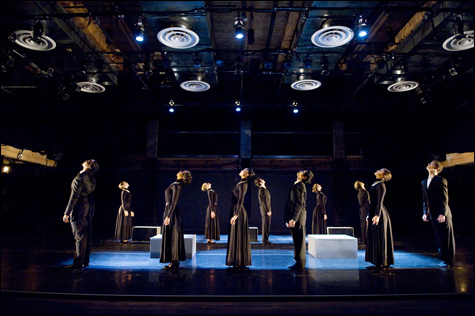
FROM THE DIARIES OF FRANZ KAFKA Boston Conservatory paid tribute to Anna Sokolow with this late work. |
Last month, students at Boston Conservatory and Boston University paid tribute to two notables of modern dance's second generation in the best possible way: by performing their work. Anna Sokolow, a member of Martha Graham's extraordinary company of women in the 1930s, would have been 100 this year. Joseph Gifford, who taught at the progressive New Dance Group and danced with Doris Humphrey and Charles Weidman in the '40s, was on the BU faculty for many years. He will be 90 in May.
For Sokolow, Gifford, and their colleagues, modern dance became a vehicle for personal and political activism. Without being literal, those dancers wanted to enact crisis. Movement had to be simple but powerful, stripped of pyrotechnics and glamour, of anything that would distance performer from spectator. For today's young dancers, who are focused on technical skills, vintage material like this must take some shift of mind as well as body.
Boston Conservatory staged two big Sokolow works at Midway Studios, under the direction of Jim May, who danced with the choreographer for many years and carries on her æsthetic in his Sokolow Theater Dance Ensemble. From the Diaries of Franz Kafka is late Sokolow. (She died in 2000.) It was made in 1981, when she was teaching movement for actors at the Juilliard School. Her choreography always stemmed from a dramatic impulse, and here she orchestrated a whole community using little more than gesture, focus, and collective motivation, plus a selection of short, elegiac pieces by Schumann, Schubert, Bloch, Schoenberg, and Mahler. One of the 12 dancers emerges from the group to quote Kafka's confessions of doubt, alienation, and delusion.
With the most sparing of imagery, Sokolow puts the group in motion walking, then spinning and laughing and pairing off. The Kafka figure stands off to the side as they waltz together quietly, each pair with their own secrets. The men stand with their backs to the audience, sketching the movements of prayer in a synagogue. "Am I a Jew?" asks the narrator.
Finally, he lies on the floor, and the others bend over him, as if they were about to pick up his coffin — or devour his body. They throw him in the air three times. He lies twisted, pinned to the ground. The others call out to him, but he's lost. He's turned into an insect.
Rooms (1955), to a commissioned third-stream-jazz score by Kenyon Hopkins, became Sokolow's signature piece. In this suite of desperate portraits, she crystalized the age of anxiety. The seven dancers sit on chairs, spaced apart, reaching, groping, trembling with desire but unable to touch one another. A woman imagines a lover who never materializes. A man vibrates with nervous energy. These are feelings we recognize, but they're intensified, almost unbearable.
I haven't seen a performance of Rooms in years that captures the desperation Sokolow demanded. She was known as a cruel master, flogging dancers to get deeper and ever deeper into their own misery, to attain a state so distilled that the angst would become impersonal, universal. Her Kafka dance isn't exactly mellow, but its tone suggests melancholia rather than Rooms' concentrated neurosis.